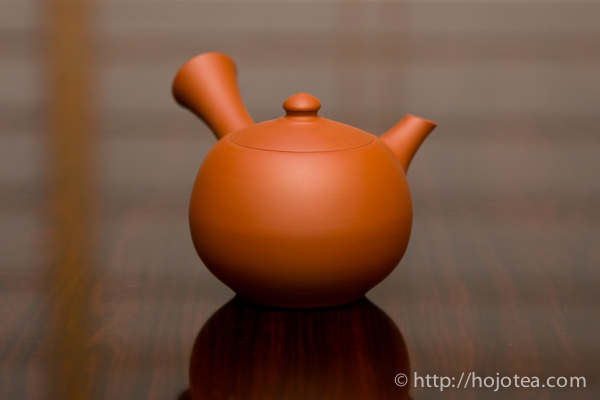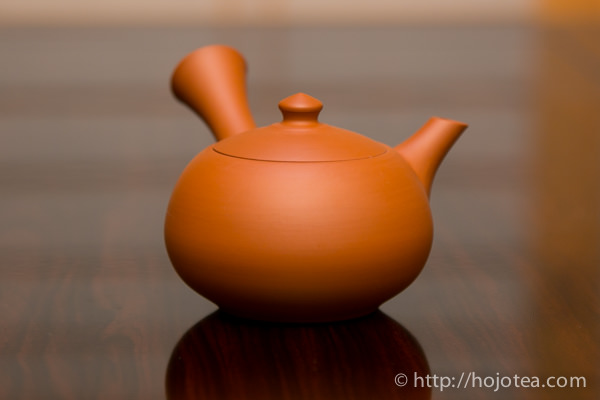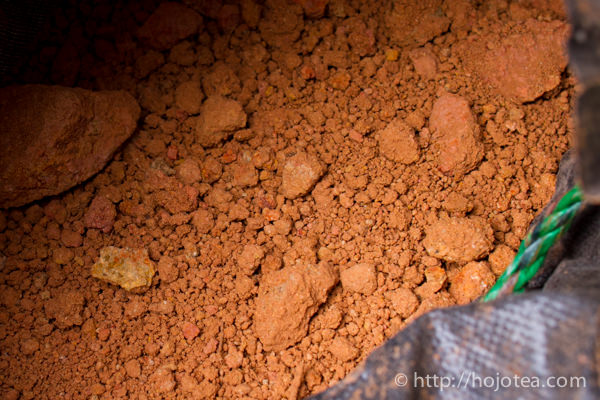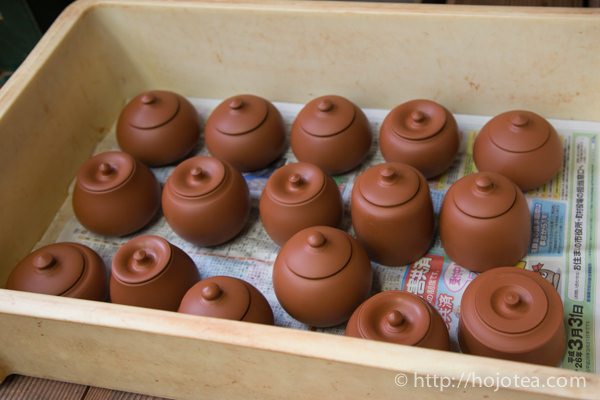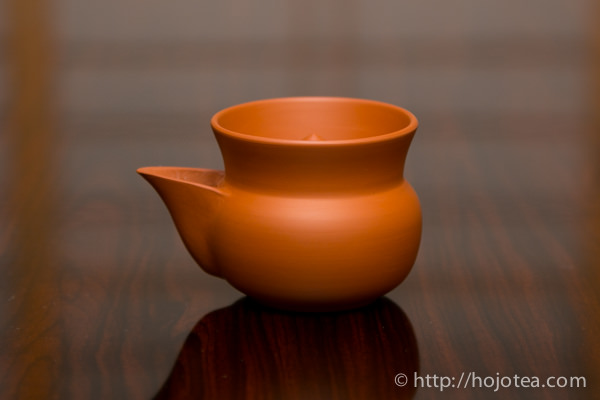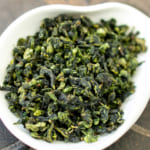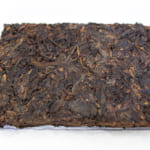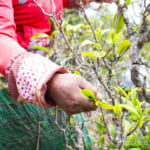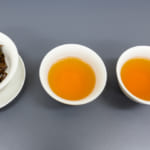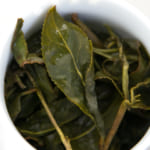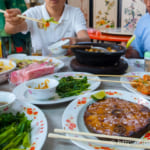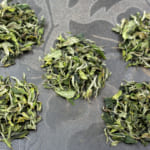- HOME >
- Teapot and Tea Equipment
2 types of clay used for Mumoyi Yaki in Sado Island
In Japan, the pottery in Sado Island that uses natural red clay is called the Mumyoi Yaki (無名異焼). The Mumyoi Yaki is defined as the clay ware made of “Shudei” (朱泥), collected from the Aikawa gold mine and the surrounding mountains. However, if you understand more about the Mumyoi Yaki, you would know that there are 2 types of clays involved. One of the clays is the Nosaka clay that has a yellowish-beige color and it is sticky as it consists of very fine particles, while another type of clay is called the Mumyoi clay which is of orange-red color where the particles are coarser. Both types of clay exist around the Aikawa gold mine area. According to the definition, the clay ware is still known as the Mumyoi Yaki regardless using either one clay or both. Usually, to produce a tea ware of 100% Mumyoi clay is very difficult as it is a little too coarse for the artist to shape. In Japan, majority of artists operate on a potter’s wheel for their work; thus, the clay has to be elastic enough to mold. Hence, it is a common practice to add in a certain percentage of Nosaka clay with the Mumyoi clay to make it malleable enough.
Here is a summary of the Mumyoi Yaki as follow.
- It involves Mumyoi clay and Nosaka clay or either one of 2.
- The artist obtains the clay by themselves and carries out the entire refining process by themselves before it can be molded.
- It resembles the traditions of China Yi Xing teapot production in many ways.
In the quest of clay that improves the taste of tea, we’ve produced teapots using 100% Nosaka Clay and Mumyoi Clay (Mumyoi clay + minor percentage of Nosaka clay). Despite the obvious difference in appearance of these clays (as I’ve mentioned earlier), the color and the appearance of teapot after firing is almost indistinguishable. Thru the history of Mumyoi Yaki in Sado Island, the potters would blend the clays and set a firing temperature only based on the appearance of the tea ware. We, however, discovered that these two types of clay give a completely adverse effect on the taste of water or tea; therefore, we select our own clay based on the effect of taste.
The reason why we introduced 2 types of clay from Sado Island
Nosaka increases the after taste
The Nosaka clay selectively increases the aftertaste of tea but not so much obvious in increasing the body. The tea brewed in Nosaka gives a transparent, clear and smooth image. Moreover, the flavor of tea becomes softer, yet long lasting.
Mumyoi clay increases body
The Mumyoi clay significantly increases the body of tea as well as the after taste. Plus, the flavor of tea brewed using a Mumyoi clay tea ware becomes richer, bolder and wider. This clay performs very well with fermented tea such as Oolong and Black tea. I personally love Taiwanese and Darjeeling tea being brewed in this clay.
Upgrading of the Mumyoi clay
We’ve made some improvement to the Mumyoi clay by analyzing the refining method of clay; by that, we managed to increase the level of the aftertaste and body even more than the previous batch. This is the 3rd successful improvement of this clay in my history.
Related Articles
How to get the latest update on HOJO Tea?
1. Follow Twitter, 2. Click "Like" on Facebook, and 3. Subscribe in newsletter. You can have the latest tea news from HOJO Tea.
 Subscribe the Newsletter to enjoy the privileges
Subscribe the Newsletter to enjoy the privileges- You may receive a free sample upon purchase, or you may have the priority to purchase special products. So please remember to subscribe our newsletter as well as the social network.
- New Release of Lan Yun Tie Guan Yin from Anxi
- Lan Yun Tie Guan Yin from Anxi, is not just an ordinary Tie Guan Yin. It has a strikingly delightful flavor reminiscent of orchid flowers with silky-soft drinking sensation. Anxi, renowned as one of the three major Oolong tea production regions in China. Anxi is recognized as one of the three major Oolong tea-producing regions …
- The new release of Bao Dao Shan Da Cha Tou Brick 2017, exclusively crafted from Da Cha Tou leaves
- Bao Dao Shan Cha Tou Zhuan 2017 is a ripe pu-erh tea crafted into brick form. Bao Dao Shan is the name of the mountain situated in the southwestern part of Yunnan. “Cha Tou” denotes a distinctive type of ripe pu-erh tea. In the course of fermenting spring tea, certain tea clumps naturally develop, known …
NEW ARTICLES
 Yunnan 2024 Spring Tea Sourcing
Yunnan 2024 Spring Tea Sourcing- Yunnan Province is globally renowned for the exceptional quality of its tea leaves. However, lax production management often presents challenges in achieving the desired tea quality when relying solely on pre-made teas. To address this issue, we have committed to remaining on-site throughout the spring season to closely monitor tea production. We are meticulously inspecting …
 The Relationship Between Greenness of Tea Leaves and Fertilizer
The Relationship Between Greenness of Tea Leaves and Fertilizer- For both tea and vegetables, there’s a common misconception that a deeper green colour indicates better quality and greater health benefits. However, this isn’t always the case. Natural plants often have a yellowish-green hue rather than a vibrant green. If you observe wild plants in grasslands or along roadsides during spring, you’ll notice that they …
 Creating Muscatel Black Tea Using a Unique Blending Method
Creating Muscatel Black Tea Using a Unique Blending Method- I would like to introduce the unique creation of black tea with a distinctive muscatel flavor profile. Acquiring Exceptional Mi Xiang Black Tea Have you ever heard of a unique black tea called “Mi Xiang Black Tea” or “Muscatel Black Tea”? This tea is crafted from leaves that have been delicately nibbled by leafhoppers, resulting …
 New Release of Lan Yun Tie Guan Yin from Anxi
New Release of Lan Yun Tie Guan Yin from Anxi- Lan Yun Tie Guan Yin from Anxi, is not just an ordinary Tie Guan Yin. It has a strikingly delightful flavor reminiscent of orchid flowers with silky-soft drinking sensation. Anxi, renowned as one of the three major Oolong tea production regions in China. Anxi is recognized as one of the three major Oolong tea-producing regions …
 The Difference Between Fermentation in Tea and Fermented Foods
The Difference Between Fermentation in Tea and Fermented Foods- Black tea and oolong tea are often categorized as “fermented teas,” but the extent to which they undergo fermentation raises questions about whether they truly qualify as fermented foods. In this article, I endeavour to offer a thorough exploration of the distinctions between tea and traditional fermented foods, shedding light on the nuances of their …
 Easy Way to Prepare Flavorful and Warm Tea at the Workplace
Easy Way to Prepare Flavorful and Warm Tea at the Workplace- Have you ever experienced the transformation of tea stored in a thermos or water bottle at work, turning into a brown hue and acquiring a bitter, astringent taste? As this has piqued the interest of many, I would like to offer a more in-depth explanation for a solution. Tea stored in a thermos undergoes oxidation …
 The new release of Bao Dao Shan Da Cha Tou Brick 2017, exclusively crafted from Da Cha Tou leaves
The new release of Bao Dao Shan Da Cha Tou Brick 2017, exclusively crafted from Da Cha Tou leaves- Bao Dao Shan Cha Tou Zhuan 2017 is a ripe pu-erh tea crafted into brick form. Bao Dao Shan is the name of the mountain situated in the southwestern part of Yunnan. “Cha Tou” denotes a distinctive type of ripe pu-erh tea. In the course of fermenting spring tea, certain tea clumps naturally develop, known …
 We released Lapsang Suchong Qi Zhong Classic: Premium Lapsang Souchong
We released Lapsang Suchong Qi Zhong Classic: Premium Lapsang Souchong- Lapsang Souchong is one of the earliest known black teas distinguished by a unique production method and flavour profile. Its origins are often linked to the Wuyi Mountains in China’s Fujian province, where Lapsang Souchong is traditionally crafted. Black tea production in the Wuyi region has a history dating back several centuries. Lapsang Souchong tea …
 Regular Consumption of Umami Seasoning Can Influence Taste Preferences
Regular Consumption of Umami Seasoning Can Influence Taste Preferences- Excessive consumption of artificial condiments, such as umami seasonings, is believed to influence one’s taste and preferences. I’d like to share my own view to explore how an overabundance of condiments can indeed influence one’s palate. Umami Seasonings Are Prevalent in Asian Countries I spend half of the year living abroad, particularly in China and …
 Special Release Limited Set of Ancient White Tea from 5 Gardens
Special Release Limited Set of Ancient White Tea from 5 Gardens- The ancient white tea is a very popular tea in our store. We produced this tea in spring. Following production, it was stored in an oxygen-free environment for several months to further enhance its flavor, achieving the expected maturation. The production of ancient tree white tea is limited in quantity per day, resulting in small …
Shop Info

Address:Lot No. T-215, 3rd Floor, The Gardens Mall, Mid Valley City, Lingkaran Syed Putra, 59200 Kuala Lumpur
Tel: +603-2287-4537
Business Hour: 10am to 10pm
Category
- New Arrival at HOJO Online Shop
- Featured Articles
- Newsletter
- Types of Tea
- Origin of Tea
- Teapot and Tea Equipment
- Tea Column
- How to enjoy tea
- Tea Processing
- How to choose quality tea
- Tea constituents and functional effect
- Safety of Tea
- Foods
- Tea Business Operation
- Hobby and Outdoor Activity
- Ranking of Tea
- Video
- FAQ
- Media Release
Profile

- AKIRA HOJO
- I invite you to experience my tea selections.I was born in Nagano, Japan. In university, I studied agricultural chemistry, and I have the master degree in food science. I worked in Japanese food industry for 10 years. I involved in R&D, QC and QA. As a factory manager, I implemented ISO9000 series and managed the factory.
- The Art of Tea Magazine
- We posted the article on “The Art of Tea Magazine No.9, the magazine is published in Taiwan. We featured some scientific view about the tetsubin
- New Straits Times
- The Malaysian National Newspaper, New Straits Times featured HOJO Tea on 17-Oct-2007.


